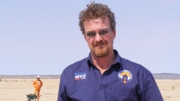
by Andy Green
This year started with an unusually wet season in the Northern Cape. Hakskeen Pan was still under water in May, and the track preparation team didn’t get back onto the Pan until late June – about 2 months later than we were expecting. Luckily, the start of the new rainy season (normally around November) has been delayed, so work has continued right into December and the team has pretty much caught up.
Picture above: Working through the summer heat
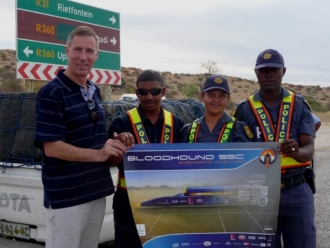 During the journey up to the Pan, we got a sense of just how much the Northern Cape is behind the Project. We were stopped at a routine police checkpoint about 100 km south of Hakskeen Pan (no, we weren’t speeding!) and recognised almost immediately. They only had one question: ‘When is the BLOODHOUND Car coming?’. Just like us, they can’t wait for us to get started.
During the journey up to the Pan, we got a sense of just how much the Northern Cape is behind the Project. We were stopped at a routine police checkpoint about 100 km south of Hakskeen Pan (no, we weren’t speeding!) and recognised almost immediately. They only had one question: ‘When is the BLOODHOUND Car coming?’. Just like us, they can’t wait for us to get started.
Picture right: BLOODHOUND supporters looking forward to some off-road speeding
Preparing the track has been a huge effort for them, as working in December (high summer in the Northern Cape, when Pan temperatures regularly exceed 40 deg C) is much harder than working in the cooler part of the year.
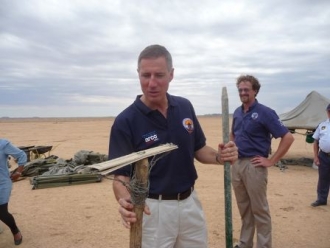 Picture left: Tools of the trade – scrapers and pry bars – with Rudi Riek, BLOODHOUND’s ‘Track Boss’ in the background
Picture left: Tools of the trade – scrapers and pry bars – with Rudi Riek, BLOODHOUND’s ‘Track Boss’ in the background
Picture below: Piles of stones cleared from the track
 The Northern Cape team, consisting of some 317 people drawn from the 5 local townships, can look back with pride on their achievements so far. As 2011 comes to an end, the preparation of the main track for BLOODHOUND (500m wide by 19km long) is just about complete: this has required almost 10 million square metres of desert to be cleared by hand, a truly amazing effort.
The Northern Cape team, consisting of some 317 people drawn from the 5 local townships, can look back with pride on their achievements so far. As 2011 comes to an end, the preparation of the main track for BLOODHOUND (500m wide by 19km long) is just about complete: this has required almost 10 million square metres of desert to be cleared by hand, a truly amazing effort.
The next few months of rains will smooth and repair the surface, leaving the world’s best race track ready for BLOODHOUND to arrive in 2013.

Picture left: BLOODHOUND’s Track Layout
However, that’s not the end of the work for the Northern Cape team – far from it. They still have to clear all of the safety zones either side of the track (another 10-12 million sq m), repair the fencing around the track and then build visitor facilities for the thousands of spectators that they are expecting.
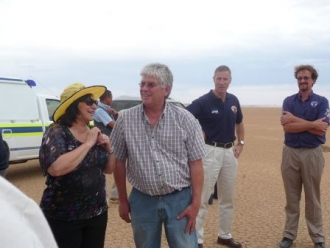
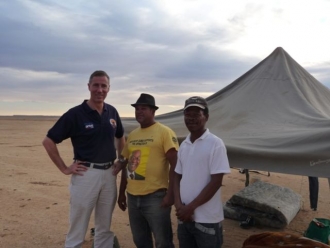
Above left : Nico Fourie, Northern Cape Project Manager, briefs the Premier of the Northern Cape (The Right Honourable Hazel Jenkins) on this year’s progress
Above right: Two night watchmen live out on the desert to protect the tools and equipment
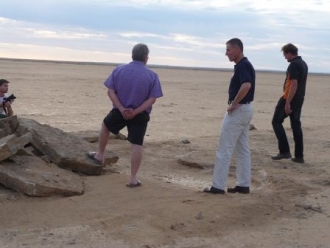 Picture right: There are some big stones out there
Picture right: There are some big stones out there
As well as picking up the millions of small stones that lie on the surface of Hakskeen Pan, the team has found some large slabs of rock lying just on the surface. Each of these slabs has been broken up and prised out by hand, ready for the heavy machinery to come and remove it all next year, once the work is complete. We will have to make certain that every one of the slabs has been found and removed before we start to run BLOODHOUND SSC – driving over one of them at 1000 mph is probably not a good idea.
The other major challenge for the Northern Cape has been the removal of the causeway. Until a few years ago, this elevated man-made road across the Pan was a part of the local road system. The causeway has now been replaced by the new R31 tarmac road which runs across the top of the Pan (which also makes Hakskeen the easiest World Land Speed Record track to get to).
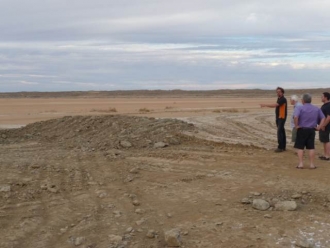
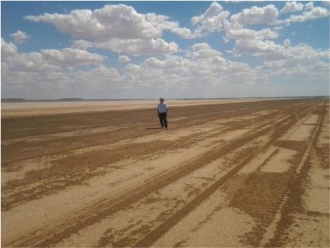
Above left: removing the causeway...and right, the finished product
The closure of the causeway has allowed us to remove it, which makes the Pan long enough for BLOODHOUND. Here’s the challenge though – no-one has ever tried to remove this size of obstacle from a dry lake bed, so we are (if you will excuse the pun) breaking new ground with the track preparation.
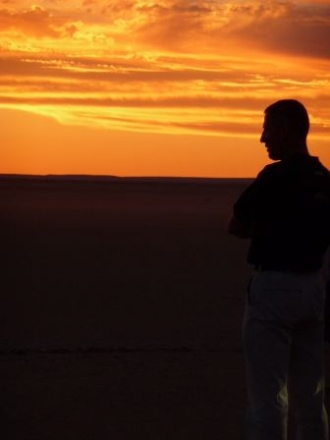 The removal of the causeway involved digging up the raised clay road (over a 1500 metre length), putting it back into the ‘borrow holes’ from where it originally came, and then levelling the causeway area, the nearby rutted tracks, and the borrow holes. All of this work had to be done to within millimetres of accuracy – there is no such thing as a small bump at 1000 mph. The good news is that the Northern Cape road engineers have already finished the removal work, so we now have the 2011/12 rainy season, and the 2012/13 rains, to allow the Pan to rehabilitate fully to its original perfect flat surface.
The removal of the causeway involved digging up the raised clay road (over a 1500 metre length), putting it back into the ‘borrow holes’ from where it originally came, and then levelling the causeway area, the nearby rutted tracks, and the borrow holes. All of this work had to be done to within millimetres of accuracy – there is no such thing as a small bump at 1000 mph. The good news is that the Northern Cape road engineers have already finished the removal work, so we now have the 2011/12 rainy season, and the 2012/13 rains, to allow the Pan to rehabilitate fully to its original perfect flat surface.
So that’s it for 2011. The main track is now stone free, the causeway has gone, and the rains are working their magic to restore the Pan back to its smooth, flat, hard surface. There’s plenty more work to do in 2012 to prepare the surrounding areas but, in the meantime, the Northern Cape team has a few months off for the rainy season. They’ve done an amazing job in 2011 and the world’s best race track is very much on schedule for the world’s fastest car!
Picture right: A busy year on the Pan comes to an end.



